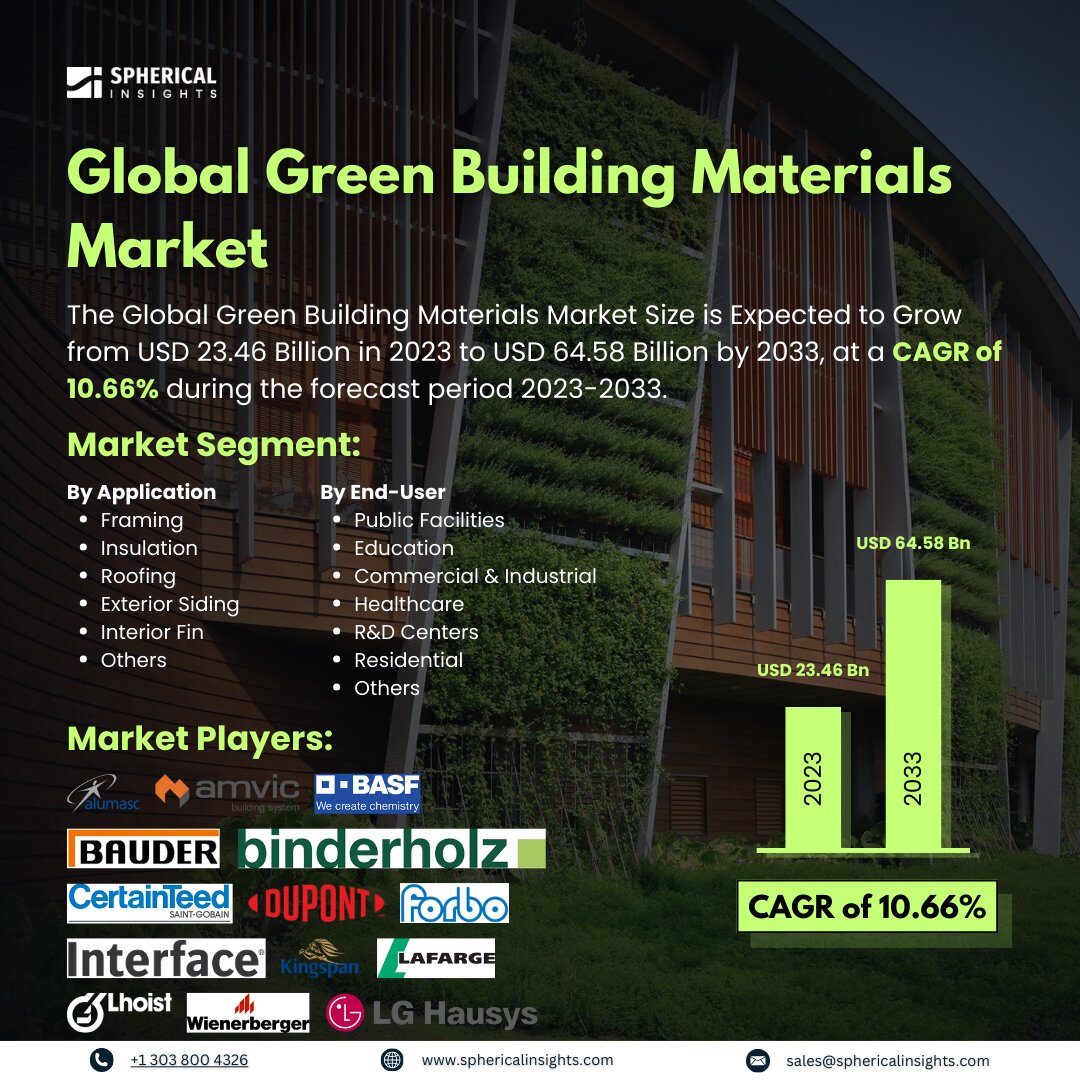Global Green Building Materials Market Size to worth USD 64.58 Billion by 2033
According to a research report published by Spherical Insights & Consulting, the Global Green Building Materials Market Size is Expected to Grow from USD 23.46 Billion in 2023 to USD 64.58 Billion by 2033, at a CAGR of 10.66% during the forecast period 2023-2033.
Browse key industry insights spread across 210 pages with 110 Market data tables and figures & charts from the report on the Global Green Building Materials Market Size, Share, and COVID-19 Impact Analysis By Application (Framing, Insulation, Roofing, Exterior Siding, Interior Fin, and Others), By End-User (Public Facilities, Education, Commercial & Industrial, Healthcare, R&D Centers, Residential, and Others), and By Region (North America, Europe, Asia-Pacific, Latin America, Middle East, and Africa), Analysis and Forecast 2023 – 2033.
The manufacturing and distribution of sustainable and ecologically friendly building materials is referred to as the green building materials market. From design and construction to upkeep and disposal, these materials are intended to lessen the environmental effects of buildings. Green building materials are becoming more and more in demand due to government requirements and rising consumer awareness of energy-efficient construction. Globally, the market is seeing an increase in interest in sustainable construction. Green building methods and materials are being used by builders more and more to lessen their environmental impact. The demand for green building products in both the residential and commercial sectors is being driven by a variety of incentives and policy pushes from governments throughout the world to encourage the use of environmentally friendly construction techniques and materials. Sustainability is gaining prominence among homeowners, building developers, and consumers, particularly younger buyers. Green properties, modular, recyclable, and natural materials are preferred for energy efficiency, healthier indoor environments, and improved employee morale. However, high capital costs in green building materials hinder the widespread adoption of sustainable practices, as plant-based alternatives often require a premium over traditional materials.
The insulation segment accounted highest share of 34.67% in 2023 and is expected to grow at a significant CAGR during the forecast period.
Based on the application, the green building materials market is classified into framing, insulation, roofing, exterior siding, interior fin, and others. Among these, the insulation segment accounted highest share of 34.67% in 2023 and is expected to grow at a significant CAGR during the forecast period. The market for green building materials has seen insulation contribute the most out of all applications due to growing concerns about energy efficiency. Developers and construction firms are increasingly concentrating on using green insulation materials, which can provide better thermal resistance and reduce building heating and cooling expenses, as environmental sustainability gains greater attention on a global scale.
The commercial and industrial segment accounted for 36.83% of the market share in 2023 and is expected to grow at a significant CAGR during the forecast period.
Based on the end-user, the green building materials market is divided into public facilities, education, commercial & industrial, healthcare, R&D centers, residential, and others. Among these, the commercial and industrial segment accounted for 36.83% of the market share in 2023 and is expected to grow at a significant CAGR during the forecast period. Rapid urbanization and a growing emphasis on sustainable building methods across cities and sectors have been driving this segment's robust expansion.
North America is estimated to hold the largest share of the green building materials market over the forecast period.
North America is estimated to hold the largest share of the green building materials market over the forecast period. The U.S. is the largest market for green building products, driven by environmental awareness and government regulations. Large cities have implemented green building codes and incentives, making North America an innovation hub. Affordable, eco-friendly materials are available across the continent, and the region's high export activity highlights its leadership in sustainable construction technologies. Cities like San Francisco, Chicago, and Seattle are key hubs for green building applications.
Asia Pacific is predicted to have the fastest CAGR growth in the green building materials market over the forecast period. China, India, and Indonesia are leading construction projects due to urbanization and infrastructure development. Government policies, sustainable technologies, and environmentally conscious design contribute to green building adoption. Cost-effective manufacturing facilities, flexible trade regulations, and improved certification protocols further support green building.
Competitive Analysis
Major key players in the green building materials market include Alumasc Group Plc, Amvik Systems, BASF SE, Bauder Limited, Binderholz GmbH, CertainTeed Corporation, E. I. du Pont de Nemours and Company, Forbo International SA., Interface Inc., Kingspan Group plc, Lafarge, Lhoist UK Ltd, Wienerberger AG, LG Hausys Ltd., RedBuilt LLC, PPG Industries, Inc., BASF SE, and Others.
Recent Development
- In January 2025, Wienerberger India introduced Porotherm Smart Bricks, which are composed of 90% recycled materials. When compared to conventional materials, the carbon footprint of these bricks is substantially reduced.
Key Target Audience
- Market Players
- Investors
- End-users
- Government Authorities
- Consulting And Research Firm
- Venture capitalists
- Value-Added Resellers (VARs)
Market Segment
This study forecasts revenue at global, regional, and country levels from 2023 to 2033. Spherical Insights has segmented the green building materials market based on the below-mentioned segments:
Global Green Building Materials Market, By Application
- Framing
- Insulation
- Roofing
- Exterior Siding
- Interior Fin
- Others
Global Green Building Materials Market, By End-User
- Public Facilities
- Education
- Commercial & Industrial
- Healthcare
- R&D Centers
- Residential
- Others
Global Green Building Materials Market, By Regional Analysis
- North America
- Europe
- Germany
- UK
- France
- Italy
- Spain
- Russia
- Rest of Europe
- Asia Pacific
- China
- Japan
- India
- South Korea
- Australia
- Rest of Asia Pacific
- South America
- Brazil
- Argentina
- Rest of South America
- Middle East & Africa
- UAE
- Saudi Arabia
- Qatar
- South Africa
- Rest of the Middle East & Africa



